The liver fluke, a flatworm with suckers, is found in the bile ducts, where it causes thickening of the walls and liver damage.
Horses that graze in marshy areas or drink from rivers are at risk, especially if sheep and cattle share the pasture. Liver fluke are also carried by rivers or heavy rain run-off. Infection can even occur where there’s no contact with sheep and cattle.
It’s also a disease that affects humans, but only if they eat raw vegetables or chew on the grass found along riverbanks. People cannot catch liver fluke directly from animals.
What is it exactly?
The liver fluke belongs to a group of flatworms known as trematodes – parasites that live in several hosts during their life cycles.
READ: Controlling liver fluke disease
It’s flat, leaf-shaped and a pale brown colour, with tiny sharp spines that irritate the liver tissue of animals. The adult, which is usually about 2cm to 3cm long, lays its eggs in the bile ducts of the liver.
The egg passes into the intestine and is excreted via the manure. If the eggs enter water, they hatch into small larvae known as miracidia.
These swim around until they find a small water snail on a leaf near the riverbank. After entering the snail they encyst (enclose themselves in a sac) and become dormant.
After about six weeks, they hatch into tiny tadpole-shaped cercariae. These attach themselves to water plants, usually grass, where they encyst again into metacercariae.
When the plant is eaten by the animal, the metacercariae penetrate the intestinal wall, enter the abdominal cavity and start eating their way into the liver.
After another six weeks or so, they make their way to a bile duct to reproduce.
Symptoms in horses
The most obvious are anaemia, oedema (swelling under the chin, on the chest or on the bottom of the abdomen) and severe weight loss. Colic and chronic watery or dark diarrhoea are other signs.
Research carried out about 20 years ago in South Africa indicated that horses are more resistant to liver fluke than sheep and cattle. Younger horses, however, seem to be more susceptible than older ones.
Diseases that can be confused with liver fluke include starvation, chronic biliary, chronic forms of horse-sickness, bleeding stomach ulcers and plant poisoning.
A reliable diagnosis can be made if fluke eggs are found in the dung. But the technique is different to that used for ordinary worm eggs, and owners who suspect their horse may have liver fluke should ask for a fluke test.
Treatment and control
The best treatment for fascioliasis in horses is triclabendazole, a member of the benzimidazole family of anthelmintics (drugs that expel worms from the body).
Drugs used for sheep and cattle can be toxic to horses, so seek your vet’s advice if you’re considering using these.
As for control, don’t allow horses to graze in marshy areas with cattle and sheep.
Email Dr Mac c/o Chris Nel on [email protected].













